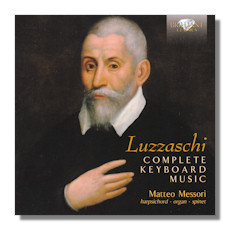
The Internet's Premier Classical Music Source
Related Links
- Latest Reviews
- More Reviews
-
By Composer
-
Collections
DVD & Blu-ray
Books
Concert Reviews
Articles/Interviews
Software
Audio
Search Amazon
Recommended Links
Site News
 CD Review
CD Review
Luzzasco Luzzaschi

Complete Keyboard Music
- Il secondo libro de ricercari a quattro voci: Ricercar #1-12
- Il Transilvano:
- Ricercare del primo tuono a quattro
- Ricercare del secondo tuono a quattro
- Toccata del quarto tuono
- Canto fermo a quattro sopra "La Spagna"
- Canto fermo a quattro sopra "Ave maris stella"
- Canzona
Matteo Messori, harpsichords, organ, spinet
Brilliant Classics 94169
Luzzasco Luzzaschi lived from about 1545 to 1607. He was one of many composers, artists, poets and even philosophers to benefit from the patronage of the Este family in Ferrara in north central Italy. Although best known for his madrigals, Luzzaschi was evidently so accomplished also as a keyboard player that he attracted the admiration (and envy) of his contemporaries. Established as organist at Ferrara, Luzzaschi's influence was significant – not least on his great pupil, Frescobaldi. Luzzaschi's style was typical of the practice at Ferrara of eschewing overdone ornamentation while at the same time developing complex and profound counterpoint.
This is just what we hear on this excellent CD from Brilliant with Italian specialist Matteo Messori: an emphasis of substance over surface. He plays modern harpsichords built after anonymous Venetian and Neapolitan originals; the organ built by Giovanni Cipri in 1556 at Ferrara and later moved to Bologna where it was restored and enlarged in the 18th, 19th and late 20th centuries; and a modern spinet after Guarracino. Even if Luzzaschi's music were not varied and creative at every turn, this variety of palette in the keyboard instruments chosen aids our understanding and appreciation of the composer's use of color and timbre.
Of the dozen and a half pieces on the 72-minute CD, the majority (14) are in the ricercar form, which can imply several musical directions taken by composers. In this case Luzzaschi's works are mostly contrapuntal, serious and tend towards long notes, rather than having multiple runs and elaborations. Although he composed and published three books of ricercari, only the second survives; one ricercar for each tone is presented, but – unusually – in relation to the last notes of each mode, not the first. Zarlino's treatise of 1558 clearly influenced Luzzaschi.
Messori's playing is gentle and sensitive when it needs to hold back, as in the Eleventh Ricercar [tr.12]; more dominant (though never strident) when he feels the need to emphasize a melodic or harmonic line, as in the very next ricercar, where a controlled rhetoric is appropriate. And is attuned well enough to the idiom to touch all shades in between. The nett result is never dry or merely "exemplary". Messori opens Luzzaschi's world as the creator of music that's compelling and beautiful regardless of its form.
His playing gently combines a graceful dignity (as in the Ricercare del primo tuono a quattro [tr.14], for instance) with sureness and a clean sense of the inevitability with which the music is meant to unfold… the very next piece, the Ricercare del secondo tuono a quattro [tr.15] is a good example. But there's neither spurious rhetoric nor inflexibility. Messori's intelligent use of tempi has much to do with this… control, lack of rush, sense of savoring every note and phrase. What's more, Messori fails to place himself between Luzzaschi and listener. This is exactly the style of playing wanted for a composer who – for all his strengths and depths – will be new or unfamiliar to many listeners. On the one hand you come away with the impression that you have actually somehow known this music's gravity, beauty and centrality to subsequent chamber music for as long as you can remember. On the other, Messori's playing makes it fresh, challenging and intriguing in a variety of ways.
The acoustics of the two church buildings near Verona and in Bologna are excellent; they show this pleasing music off to its very best with a warmth and resonance that are nevertheless far from obtrusive. The booklet contains just the right amount of background on the composer and performer. It also has a useful exposition of the musical theory behind the construction of the works on the CD. This is particularly helpful: it's not always realized just how rapidly music was evolving in the late Renaissance and early Baroque. Not all these works appear to be available – certainly not on a single CD dedicated to Luzzaschi. So the appeal of the music and the quality of the playing make this one to seek out and enjoy.
Copyright © 2014, Mark Sealey


















